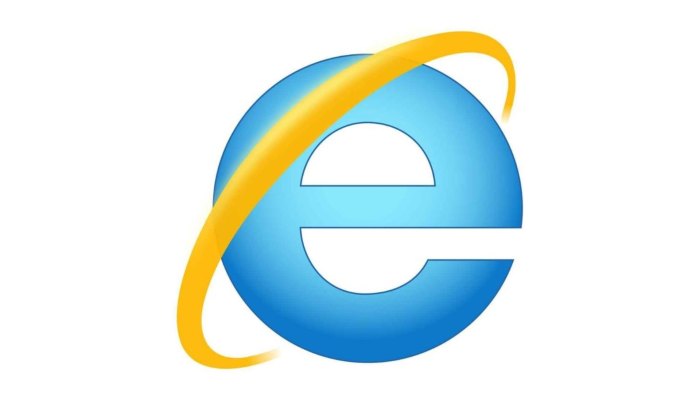The End of an Era: Microsoft’s Decision to Retire Internet Explorer
The retirement of Internet Explorer (IE) marks a significant moment in the history of the web browser. This decision signals the end of an era for a browser that once dominated the internet landscape. This decision is not a sudden one but rather a culmination of factors that have shaped the evolution of web browsing.
The History and Impact of Internet Explorer
Internet Explorer’s history is intertwined with the rise of the internet itself. Released in 1995, it quickly gained popularity, becoming the default browser on Windows operating systems. This gave IE a dominant market share, influencing the direction of web development for years. Its widespread adoption contributed to the standardization of web technologies like HTML, CSS, and JavaScript, solidifying its role as a key player in the development of the web.
However, the dominance of IE was not without its challenges. Critics pointed to its lack of adherence to web standards and its susceptibility to security vulnerabilities. The emergence of alternative browsers like Mozilla Firefox and Google Chrome challenged IE’s supremacy, introducing new features and prioritizing web standards compliance. These developments forced Microsoft to adapt, leading to the release of IE’s successor, Microsoft Edge, in 2015.
Rise of Microsoft Edge
Microsoft’s decision to retire Internet Explorer marked the end of an era, but it also paved the way for the rise of its successor, Microsoft Edge. As the new flagship web browser, Microsoft Edge has been designed to provide a modern and efficient browsing experience, addressing the shortcomings of its predecessor and embracing the evolving web landscape.
Features and Functionalities
Microsoft Edge offers a range of features and functionalities designed to enhance user experience and cater to modern browsing needs. These features include:
- Improved Performance and Efficiency: Microsoft Edge leverages the Chromium engine, known for its speed and performance, offering a significantly faster browsing experience compared to Internet Explorer.
- Enhanced Security and Privacy: Microsoft Edge prioritizes user security and privacy by incorporating robust security features, including built-in anti-tracking mechanisms and phishing protection.
- Modern Design and User Interface: Microsoft Edge boasts a clean and intuitive interface, making it easy to navigate and customize. It offers features like tab management, reading view, and a customizable toolbar for a personalized browsing experience.
- Cross-Platform Compatibility: Microsoft Edge is available across multiple platforms, including Windows, macOS, iOS, and Android, ensuring a seamless browsing experience regardless of the device.
- Integration with Microsoft Ecosystem: Microsoft Edge seamlessly integrates with other Microsoft services and products, like OneDrive, Microsoft 365, and Cortana, enhancing productivity and user experience.
Integration of Chromium Technology
Microsoft’s decision to integrate Chromium technology into Microsoft Edge was a strategic move aimed at improving the browser’s performance, compatibility, and security. Chromium, the open-source project behind Google Chrome, is widely recognized for its high performance and extensive developer community.
By adopting Chromium, Microsoft gained access to a vast pool of developers and resources, enabling them to quickly enhance Edge’s features and functionality. This move also ensured that Edge could run web applications and websites designed for Chromium-based browsers, improving compatibility and user experience.
Microsoft’s Strategy for Promoting and Transitioning Users
Microsoft has implemented a multi-pronged strategy to promote Microsoft Edge and transition users from Internet Explorer. These strategies include:
- Aggressive Marketing Campaigns: Microsoft has launched marketing campaigns across various channels, highlighting the advantages of Microsoft Edge and encouraging users to make the switch.
- Integration with Windows Updates: Microsoft has integrated Microsoft Edge into Windows updates, making it the default browser for new installations and providing users with a seamless transition experience.
- Compatibility and Migration Tools: Microsoft has developed compatibility tools and migration guides to help users transfer their bookmarks, passwords, and other browsing data from Internet Explorer to Microsoft Edge.
- Focus on Developer Support: Microsoft has invested in tools and resources for developers to ensure compatibility with Microsoft Edge and encourage the development of web applications for the browser.
Impact on Users and Businesses
The transition from Internet Explorer to Microsoft Edge might present challenges for users and businesses. It’s crucial to understand these potential roadblocks and adopt strategies for a smooth transition.
Compatibility Issues
Compatibility issues are a primary concern during the transition from Internet Explorer to Edge. Websites and applications designed for Internet Explorer might not function correctly in Edge, leading to frustration for users and disruption for businesses.
Mitigating Compatibility Issues
- Website and Application Testing: Thoroughly test all websites and applications used by your organization in Microsoft Edge to identify any compatibility issues. This step is essential to ensure seamless functionality after the transition.
- Browser Compatibility Mode: Edge includes a compatibility mode that allows users to render websites in a way that mimics Internet Explorer’s behavior. This can help resolve compatibility issues with older websites that are not yet updated for Edge.
- Updating Websites and Applications: Encourage developers and website owners to update their websites and applications to be compatible with modern browsers like Edge. This will ensure a smoother user experience for everyone.
- Using Alternative Browsers: If certain websites or applications remain incompatible with Edge, consider using alternative browsers like Google Chrome or Mozilla Firefox. These browsers have wider compatibility and can be used as a fallback option.
Importance of Website and Application Compatibility Testing
Testing is critical to avoid potential issues and ensure a smooth transition for users and businesses.
Testing Strategies
- Manual Testing: Manually browse through all essential websites and applications used by your organization in Edge. Pay close attention to functionality, layout, and any error messages.
- Automated Testing: Employ automated testing tools to systematically evaluate website and application compatibility with Edge. These tools can identify issues that might be missed during manual testing.
- User Acceptance Testing (UAT): Involve end-users in the testing process to get their feedback and identify any usability issues that might not be apparent to developers.
The Future of Web Browsers: Microsoft To Kill Off The Internet Explorer Brand
The retirement of Internet Explorer marks a significant shift in the web browser landscape, paving the way for a future defined by fierce competition and rapid innovation. As Microsoft focuses its efforts on Edge, the browser market is poised for exciting developments, with new features and technologies emerging to enhance user experience and security.
The Current Browser Landscape
The web browser market is dominated by a handful of major players, each vying for user attention and market share.
- Google Chrome: Currently holds the largest market share, exceeding 65%, thanks to its speed, user-friendly interface, and extensive extension library.
- Mozilla Firefox: Known for its privacy-focused features and strong commitment to open-source development, Firefox holds a respectable market share of around 4%.
- Apple Safari: Primarily used on Apple devices, Safari enjoys a significant market share due to its seamless integration with the Apple ecosystem.
- Microsoft Edge: With the discontinuation of Internet Explorer, Microsoft Edge is poised to gain traction, leveraging its integration with Windows and its focus on performance and security.
Emerging Trends and Innovations
The web browser market is constantly evolving, driven by user demand for enhanced features and improved security.
- Privacy Features: Browsers are increasingly incorporating privacy-enhancing features, such as built-in ad blockers, cookie management tools, and privacy-focused search engines.
- Security Enhancements: Security is paramount in the online world, and browsers are implementing advanced security measures, including sandboxing, phishing detection, and malware protection.
- Cross-Platform Compatibility: Users expect a seamless browsing experience across various devices, leading to the development of cross-platform browsers that offer consistent functionality on desktops, laptops, smartphones, and tablets.
- Artificial Intelligence (AI): AI is playing a growing role in web browsers, enabling features like intelligent search suggestions, personalized content recommendations, and automated translation.
Impact of Microsoft’s Decision, Microsoft to kill off the internet explorer brand
Microsoft’s decision to retire Internet Explorer and focus on Edge is likely to have a significant impact on the web browser market.
- Increased Competition: The shift to Edge is likely to intensify competition between Microsoft and other major browser developers, leading to faster innovation and improved features.
- Focus on Security: Microsoft’s commitment to Edge’s security and performance could encourage other browser developers to prioritize these areas.
- Market Share Shift: As users transition from Internet Explorer to Edge, Microsoft could gain a larger market share, potentially challenging Google Chrome’s dominance.
Microsoft to kill off the internet explorer brand – So, what does this mean for the future of web browsing? Microsoft’s decision to kill off Internet Explorer signals a new era of competition and innovation in the browser market. With the rise of Chromium-based browsers and a focus on user privacy and security, the battle for web dominance is far from over. As we navigate this new landscape, one thing is certain: the web is constantly evolving, and the browser we use today might not be the one we use tomorrow. The future of web browsing is full of possibilities, and it’s an exciting time to be a web user.
Microsoft’s decision to kill off the Internet Explorer brand might seem like a move to the past, but it’s actually a smart play for the future. With the rise of immersive experiences, Microsoft is betting on Edge to be the browser of choice for the metaverse. And with Google reportedly building an Android version for virtual reality, google reportedly building an android version for virtual reality , it’s clear that the future of browsing is going to be about more than just clicking links on a screen.
The race is on to see who will dominate the next generation of internet experiences, and Microsoft is clearly making a move to be a major player.
 Standi Techno News
Standi Techno News

